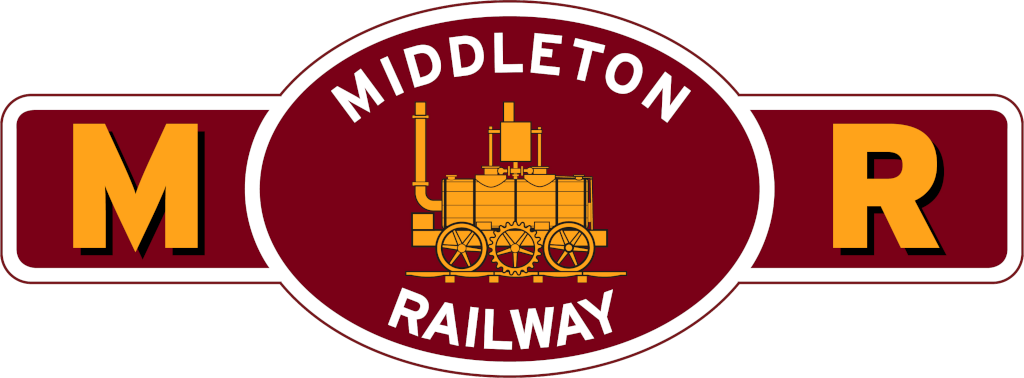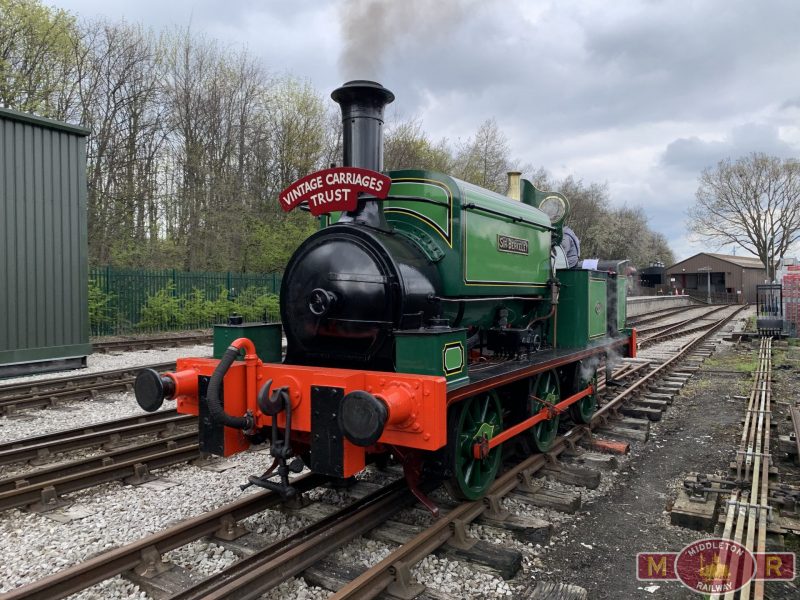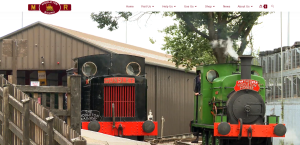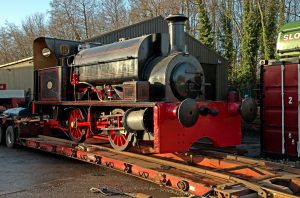On Saturday 15th April, guests and VIPs of Middleton Railway, and the Vintage Carriages Trust, along with many other people from all walks of life, got together at the Middleton Railway to welcome and rededicate Sir Berkeley back into service after many years of being overhauled.
Below is the video of the rededication, along with a transcript, from Anthony Coulls from the National Railway Museum.
The Dedication of Sir Berkeley
by Anthony Coulls of the National Railway Museum, York
15th April 2023
Baroness Blake, Ladies, Gentlemen, Everybody – Brookes Number 1!
Good Morning. It’s a pleasure to be here with you, and forgive me if my voice gives out, because I’m not sure I’ve ever had quite such competition – two steam engines, people thirty feet up there, people thirty feet over there. Normally I’d say come a bit closer, or I will come and see you, but you’re stuck behind a barrier. So I hope you can hear me.
Now it’s a fantastic occasion today, and I’m really glad that the weather has held off because we can see this engine in it’s full glory.
Now as a railway enthusiast train-mad teenager in the eighties, I developed a very unhealthy interest, as my parents might say, in the ironstone industry of the Midlands. I come from Warwickshire, we had the Edge Hill Light Railway just over the border, we had the Oxfordshire Ironstone Railway, and a number of us at school found out about this local history stuff, and yes, teenagers do do history – it’s around us now.
But by the age of fifteen I had all of the nine volumes of Eric Tonk’s magisterial work “The Ironstone Railways and Tramways of the Midlands” – look it up if you actually want a good read. It’s not one for if you’re suffering from an inability to sleep – it’s really good. I learned a lot about little steam engines, one of which was the Cranford Quarry system, the ironstone system, and a little engine called “Sir Berkeley”.
As time went on, as a teenager, I found out that that engine was still in existence, owned by the Vintage Carriages Trust and based on the Worth Valley Railway, but it hadn’t run for decades. I followed up it’s story, and finally met more of it’s illustrious past including the Railway Children appearance, which actually I’ve still never seen despite the age of digital videos etc.
Finally I met it at the Worth Valley Railway in 1998, painted in what was somewhat approximate to “Kermit green”, which was entertaining. I bought a little book “Sir Berkeley and Friends” taught me a lot more about the engine, it taught me a lot more about the VCT collection, and the dynamism that they bring to the heritage movement. It was running at that date with it’s first set of driving wheels disconnected, the coupling rods were off, which reminds me of it’s life as a contractors engine.
So often we can remember these engines within living memory, at the end of their life with the ironstone or industry, but as a contractors engine is where, I can’t say it made it’s name cos it didn’t have a name, but there it was, very much the equivalent of a dump truck in modern day contractors world. “This is no’ but a bit of kit” as my dear friend Ian Howitt would say, down in Wakefield. It’s just a thing to do a job, and actually the paint only stops it going rusty – but what a paint job!
The contractor’s railways across the UK, from dams, reservoirs, civil engineering contracts, bridge building, canals and the railway system, there were hundreds of miles of railways doing a job of work away from the Coronation Scot, away (dare i say it) from the Flying Scotsman and Mallard, engines like this were getting on, doing the business, driving British industry. They were pieces of plant, often discarded at the end of their jobs, whether it was a contact come to an end, or whether they were supplanted by a more modern piece of equipment.
And so, therefore, it’s such an amazing survival that Sir Berkeley, or Logan and Hemmingway number 30 as it was when ordered in 1890. An amazing thing that it would have a long life as it did, surviving until Roger came and bought it in 1965 for us all to enjoy now. A rare survivor, a special machine, and a very useful machine, as I proved a few years ago when we had it at Shildon, the Locomotion museum in Shildon, one of our trustees came and said “I’ve heard this story that people used to cook their breakfasts on the shovel with bacon and eggs – I don’t believe you!” So I sent a colleague of mine up to the Co-op and said “right six buns, half-a-dozen rashers of bacon”, and five minutes later one of our trustees was learning. Engines can teach us, not just how they operated, but some of these stories of ways of life and what they did.
So I might work for the National Railway Museum, in fact I’ve just hot-footed it across there less than an hour ago, and we were in the hallowed walls of Mallard, Flying Scotsman, Rocket and the high speed train, but without such engines, humble engines, as number 30 was, which built a network and existed in their hundreds, the modern railway wouldn’t necessarily have taken shape as quickly as it did.
The stunning photographs of the SWA Newton collection showing the building of the last main line, the Manchester, sorry, the London extension of the GC, show what a great endeavour civil engineering was in the building of the railways, and the part played by the contractors therein.
And so the story of Sir Berkeley comes full circle, represented for years by the VCT, and the custodians here at Middleton, in her Cranford guise, apart from the rather aesthetically pleasing tin cab, the overall cab I suspect you guys might wish it come back at some point if it rains today.
When I was the museum mentor, as these chaps have already alluded to, I did suggest that the Logan and Hemmingway livery came back in it’s next overhaul to stand as testimony to the men and machines who completed our railway system in the late 19th and early 20th century, and bless the trustees, and the people who painted it, and the folks who’ve gotta clean it and maintain it – here is the result!
I’m delighted to see it, I hope you will share in my delight.
Welcome back Sir B, or Logan and Hemmingway number 30..
Thank you very much
(Video courtesy of Chris Eden-Green. Photo courtesy of Geordie Brown)





